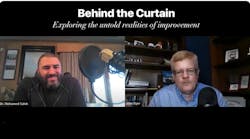Podcast: Visualizing Workflows—Navigating Value Stream Mapping vs Process Mapping
"Process mapping on steroids." That's how John Dyer used to describe value stream mapping back when VSM was just beginning to assert itself as a new continuous improvement tool and process mapping was an established technique. Both tools speak to the need to visualize flow as a critical first step to solving problems and building sustainable solutions, but they are not the same thing.
In this episode of Behind the Curtain: Adventures in Continuous Improvement, co-hosts Professor Mohamed Saleh and Dyer take a deeper dive into the nuances of both VSM and process mapping. "Value stream mapping allows us to see that customer centric perspective throughout that entire end to end process, through the entire supply chain. And from that, we're able to interrogate this to see where our biggest problems are," says Saleh.
Process mapping, as the name implies, is more manufacturing process-focused, Dyer says. Before process mapping, "when things went wrong the first thing you [did] is blame the people or blame the lack of training of people. But once you get the process mapped out, then all of a sudden it becomes clear that no one could do this."
Both Saleh and Dyer speak to mapping's ability to unmask hidden issues and eliminate assumptions, and weigh in on questions such as: Who should be included on a mapping team? and How much detail is required?
